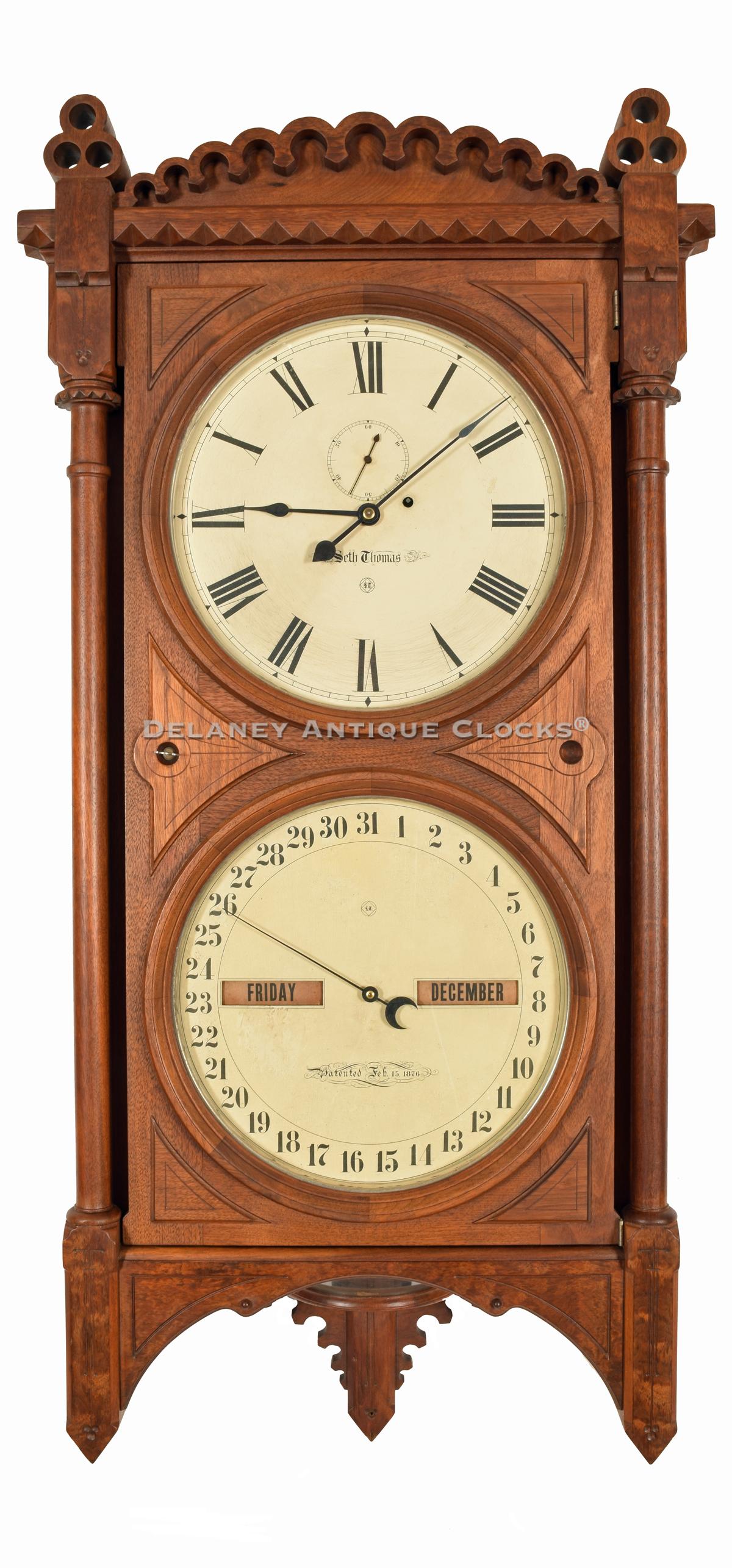Seth Thomas Office Calendar No. 5. A double-dial wall hanging calendar clock. 221137.
This attractive wall clock was made by the Seth Thomas Clock Company in Thomaston, Connecticut. It is cataloged as the "Office Calendar No. 5." This model was offered in 1884. The case is walnut and features polished French walnut trimmings or veneers. The finish has been rubbed down and waxed. The color is excellent.
The Office Calendar No. 5 measures 50 inches long, 24 inches wide, and 8 inches deep. This is a big stocky clock. Both 14-inch diameter dials are painted on zinc and are in very good original condition. The upper dial does display the Maker's trademark in the appropriate location. The time track is formatted with a closed minute ring, large Roman-style hour numerals, and a subsidiary seconds display. Behind this dial is a brass-constructed time-only movement. Rectangular-shaped plates support the steel arbors and brass gearing. It is weight-driven and designed with a dead-beat escapement and retaining power. The front plate is die-stamped with the Clockmaker's trademark. The works and the pendulum are mounted to the backboard via a cast iron mounting bracket. The cast-iron drive weight travels down the side of the case. It is suspended from a cord that threads through a pulley mounted to the upper right side of the case. This side mounting location ensures enough drop for the clock to run for eight days. The cast iron bracket also provides enough space for the pendulum to be hung behind the movement. The brass pendulum bob is partially visible in the lower section of the case. Here you will find an access door that is fitted with clear glass. The construction of this door is complex and worth noticing. The lower dial displays the calendar information. The calendar patent date, "Patented Feb. 15, 1876," is painted on this dial. Arabic style numerals representing the month's date are painted around the perimeter of this large dial. The long hand fitted to the post in the center of the dial in the center of this dial displays the appropriate date. The displays for the month and the days of the week are printed on paper rolls. These rolls are designed to rotate at the proper time. The appropriate information is displayed through the rectangular-shaped cutouts in the dial. The day of the week and the month rolls are in very good original condition. The calendar mechanism is perpetual. This means that when it is set up correctly, it will automatically adjust for the variations in the lengths of the twelve months, and it will also adjust for the leap year. This mechanism is supported by a bracket that is attached to the backboard. It gets its change orders from the time movement above.
This large double dial calendar clock was made circa 1885.
Inventory number 221217.
Seth Thomas was born in Wolcott, Connecticut, in 1785. He was apprenticed as a carpenter and joiner and worked building houses and barns. He started in the clock business in 1807, working for clockmaker Eli Terry. Thomas formed a clock-making partnership in Plymouth, Connecticut, with Eli Terry and Silas Hoadley as Terry, Thomas & Hoadley. In 1810, he bought Terry's clock business, making tall clocks with wooden movements. Seth chose to sell his shares in the partnership in 1812, moving in 1813 to Plymouth Hollow, Connecticut, where he set up a factory to make metal-movement clocks. In 1817, he added shelf and mantel clocks. By the mid-1840s, He successfully transitioned to brass movements and expanded his operations by building a brass rolling mill and a cotton factory. In 1853, He incorporated the business but continued to be the majority shareholder. This clock business expanded until it became one of the "BIG Seven" in Connecticut. Their product line had offerings that competed at every price point, from kitchen clocks to precision regulators. Seth Thomas died in 1859. The community of Plymouth Hollow so revered him that they changed the name on July 6, 1875, to Thomaston in his honor. After his death, his son, Aaron, took over the company's leadership. Aaron is credited with increasing the business by adding a number of new case styles and improving production methods. The company went out of business in the 1980s.












